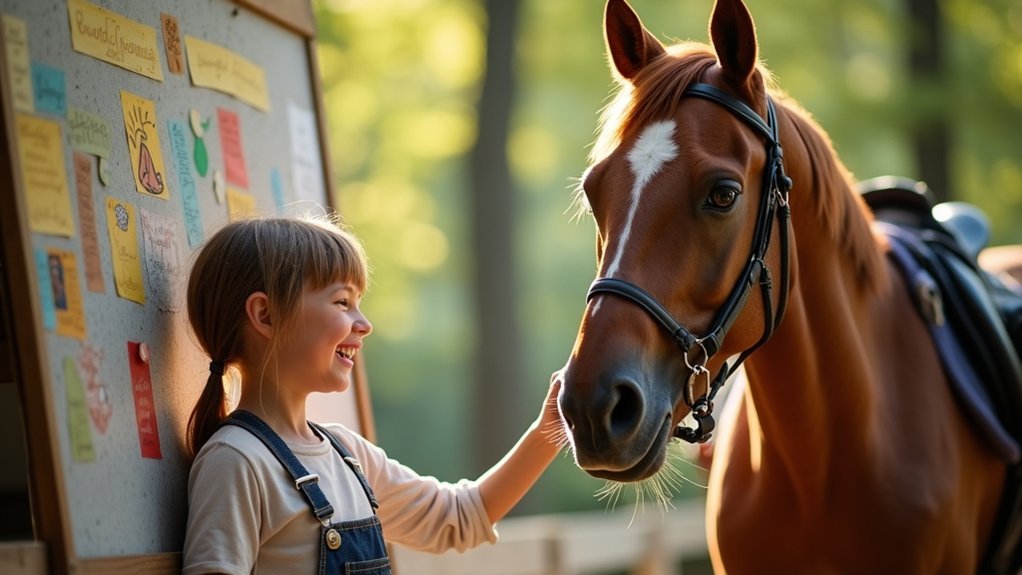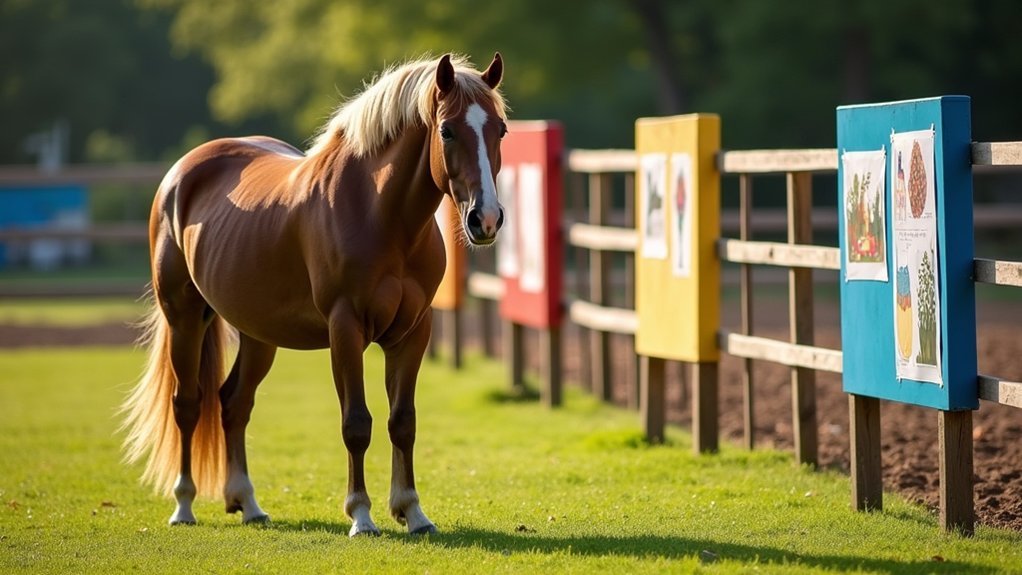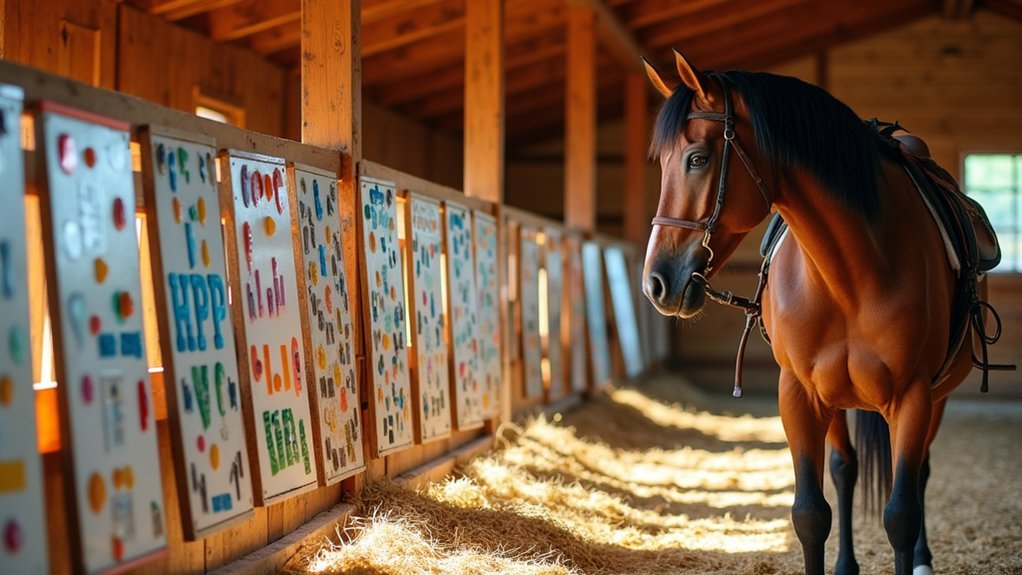Communication boards for nonverbal riders transform equine therapy by enabling choice and direction expression. You’ll find options ranging from high-tech voice output devices like TalkBook Four to simple laminated boards with riding commands. Mount these using Velcro on saddles or at accessible stations around the arena. Customize symbols based on rider ability—beginners need basic commands while advanced riders use more complex options. Discover how these affordable tools can help your riders build confidence and independence beyond the arena.
Benefits of Communication Boards in Equine-Assisted Therapy

While horses have long been recognized for their therapeutic benefits, the introduction of communication boards has revolutionized equine-assisted therapy for nonverbal riders. These AAC devices enable individuals with special needs to express choices and directions during therapeutic riding sessions, greatly enhancing their independence.
You’ll notice immediate improvements in rider-instructor interaction when using riding-related symbols on communication boards. These tools create a more effective learning environment by allowing nonverbal participants to clearly convey their wishes and feelings.
Studies confirm that enabling communication increases engagement and satisfaction, giving riders a valuable sense of control.
Research demonstrates that empowering riders through communication tools enhances their therapeutic experience, fostering autonomy and enjoyment.
The integration of communication boards aligns with educational goals too, supporting communication skill development for individuals with autism and other intellectual disabilities. Your nonverbal riders can now actively participate in their therapy experience.
Types of Visual Systems for Horseback Riding Sessions
Visual systems for horseback riding sessions range from high-tech communication devices to simple, low-cost visual supports that meet diverse rider needs.
You’ll find sophisticated electronic devices with voice output capabilities alongside economical laminated picture boards that serve similar communicative functions.
Both options provide riders with communication independence, though your choice will depend on budget constraints, rider abilities, and specific therapeutic goals.
High-Tech Communication Devices
Although traditional communication boards serve many riders well, high-tech communication devices offer enhanced options for non-verbal participants in equine therapy.
You’ll find customizable single message communicators like the TalkBook Four and GoTalk Ones particularly effective for therapeutic horseback sessions. These AAC devices can be securely mounted on saddles, guaranteeing accessibility throughout your riding experience.
Touch-activated spoken messages enable non-verbal riders to clearly communicate “go,” “stop,” “left,” or “right” commands independently.
You can supplement these high-tech options with laminated communication boards featuring riding-specific symbols to enhance interaction and choice-making abilities.
The durability of these devices guarantees they withstand repeated use across multiple sessions and riders, making them valuable investments for any equine therapy program focused on empowering communication for participants with special needs.
Low-Cost Visual Supports
Four affordable visual systems can transform communication during therapeutic riding sessions without straining your budget. Laminated communication boards with clear symbols for “go,” “stop,” “left,” and “right” provide nonverbal riders essential tools to express their needs.
You’ll find these visual supports dramatically improve engagement while empowering riders to make choices independently.
- Customizable boards featuring personalized symbols relevant to each rider’s experience, allowing for context-specific communication
- Portable wristband communicators that remain accessible throughout the session, enhancing riders’ ability to participate actively
- Simple mounted button systems attached to saddles or reins that enable immediate communication without disrupting the therapeutic riding experience
These cost-effective visual supports create a foundation for successful interaction between riders and horses, making therapeutic benefits accessible to more participants regardless of communication challenges.
Setting Up Communication Stations Around the Riding Arena

To maximize the effectiveness of your therapeutic riding program, you’ll need strategic board placement at key decision points where riders naturally pause during sessions.
Protect your communication stations with waterproof lamination and durable mounting systems that withstand arena dust, unexpected rain, and temperature fluctuations.
Create color-coded access points around your arena that help riders and instructors quickly identify which communication tools are available at each station.
Strategic Board Placement
- Mount boards securely at heights accessible to all riders, regardless of their physical abilities or whether they’re seated on horseback.
- Include clear visual symbols that align with specific riding activities occurring in each area.
- Create dedicated communication stations with multiple boards addressing different scenarios to help riders express needs and preferences.
- Position stations at natural junction points around your arena, keeping them within easy reach of riders yet safely out of main riding paths.
- Verify each color-coded access point features consistent symbols that match your communication strategy, reinforcing meaning through multiple visual cues.
- Train volunteers to direct riders to appropriate stations based on observed needs, gradually building independence in using the communication system.
- TalkBook Four communicators and GoTalk Ones can be mounted stably on saddles, providing consistent access throughout the session.
- Velcro-backed laminated communication boards allow for quick attachment to different saddles, featuring essential messages like “go,” “stop,” and directional cues.
- Durable mounting options withstand repeated use across multiple riders and horses, making your investment practical for busy therapy programs.
When strategically placed, these boards empower nonverbal riders to communicate effectively throughout their therapeutic riding experience.
Weatherproofing Your Stations
Equipping your outdoor communication stations for all weather conditions guarantees year-round accessibility for riders regardless of environmental challenges.
Choose fiber reinforced plastic boards for maximum durability against rain and sun exposure, assuring your communication tools remain functional through changing seasons.
Mount your boards in sheltered locations under arena overhangs or awnings while maintaining easy rider accessibility.
Waterproof lamination provides additional protection and simplifies cleaning after dusty riding sessions.
Implement adjustable mounting systems that allow you to reposition boards based on weather patterns, preserving visibility during different conditions.
Don’t overlook regular maintenance—schedule monthly inspections to check for weather damage and promptly replace worn components.
This proactive approach assures your weatherproof communication boards remain reliable resources for nonverbal riders throughout the year.
Color-Coded Access Points
Strategic placement of color-coded communication stations transforms your riding arena into an intuitive navigation system for nonverbal riders.
Establish distinct colors for specific messages—red for “stop,” green for “go,” and blue for directional choices—helping riders with special needs quickly identify where to communicate different needs during therapeutic riding sessions.
These thoughtfully designed stations enhance communication capabilities, giving nonverbal riders more control and engagement during their therapeutic sessions.
Customizing Boards for Different Rider Abilities and Needs

Customization serves as the cornerstone of effective communication boards for horse therapy, allowing each rider to experience meaningful interactions regardless of their abilities. When customizing communication boards for therapeutic horseback riding, you’ll need to select symbols that align with each rider’s specific needs and preferences. Small children may benefit from wrist-sized boards with simplified commands.
| Rider Type | Board Size | Symbol Examples |
|---|---|---|
| Beginners | Small/Wrist | “Go,” “Stop” |
| Intermediate | Medium | Directional symbols, pace indicators |
| Advanced | Full-sized | Expanded vocabulary, emotions |
As your riders progress, adjust their boards based on instructor feedback. Incorporate personally meaningful pictures that resonate with each individual, ensuring the symbols remain accessible as communication skills develop. Consider integrating devices like GoTalk Ones for riders who need expanded vocabulary options.
Mounting Options for Easy Access During Therapeutic Riding
Once your communication boards are tailored to each rider’s needs, securing them properly during sessions becomes the next challenge.
The Equine Therapy Communication Kit offers several mounting options designed for easy access while riding. You’ll find lightweight single message devices that attach securely to any saddle, guaranteeing riders can communicate effectively during therapeutic riding sessions.
Using these secure mounting solutions guarantees communication remains accessible when riders need it most.
Success Stories: How Communication Boards Transform Riding Experiences
Across our network of therapeutic riding centers, communication boards have revolutionized how non-verbal riders connect with their horses and instructors. These AAC tools make therapeutic riding or hippotherapy accessible to everyone, providing a powerful solution for expressing needs and preferences.
| Rider Success | Communication Outcome |
|---|---|
| Emma, age 8 | Now signals “faster” during trotting |
| Jayden, age 12 | Independently requests “left” and “right” turns |
| Maria, age 6 | Expresses feelings about different horses |
| Tyler, age 15 | Communicates when he needs a break |
You’ll notice improved interaction during sessions as riders gain confidence using their communication boards. Parents report that these skills extend beyond the arena, enhancing social engagement in everyday settings and giving non-verbal riders a voice in their therapeutic journey.
Frequently Asked Questions
What Are Three Ways to Communicate With a Horse?
You can communicate with a horse through body language (posture, hand gestures), vocalizations (specific commands, soothing tones), and touch (patting, stroking). These methods help you establish trust and understanding between you both.
What Is Therapy Using Horses to Help People With Physical or Emotional Difficulties Also Called Hippotherapy?
Yes, therapy using horses to help people with physical or emotional difficulties is also called hippotherapy. You’ll find it’s an effective treatment where you’re benefiting from the horse’s movement to improve your condition.
Is Horse Therapy Evidence Based?
Yes, horse therapy is evidence-based. You’ll find multiple peer-reviewed studies showing its effectiveness for improving physical, emotional, and social outcomes. Research confirms it helps increase self-esteem, enhance communication skills, and reduce anxiety for participants.
How Does Hippotherapy Help With Speech?
Hippotherapy helps your speech through the horse’s rhythmic movement, which improves your breathing control and oral motor skills. You’ll engage socially with therapists during sessions, creating natural opportunities for verbal expression and communication development.
In Summary
You’ve now got the tools to empower nonverbal riders through equine therapy. Whether you’re mounting boards on saddles or creating arena-wide communication stations, you’re building confidence and independence. Remember to customize each system to your rider’s unique needs and abilities. As you implement these communication boards, you’ll witness transformative moments where riders connect with their horses in meaningful ways they couldn’t express before.





Leave a Reply